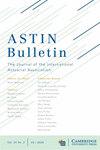COST-SENSITIVE MULTI-CLASS ADABOOST FOR UNDERSTANDING DRIVING BEHAVIOR BASED ON TELEMATICS
IF 1.8
3区 经济学
Q2 ECONOMICS
引用次数: 14
Abstract
ABSTRACT Using telematics technology, insurers are able to capture a wide range of data to better decode driver behavior, such as distance traveled and how drivers brake, accelerate, or make turns. Such additional information also helps insurers improve risk assessments for usage-based insurance, a recent industry innovation. In this article, we explore the integration of telematics information into a classification model to determine driver heterogeneity. For motor insurance during a policy year, we typically observe a large proportion of drivers with zero accidents, a lower proportion with exactly one accident, and a far lower proportion with two or more accidents. We here introduce a cost-sensitive multi-class adaptive boosting (AdaBoost) algorithm we call SAMME.C2 to handle such class imbalances. We calibrate the algorithm using empirical data collected from a telematics program in Canada and demonstrate an improved assessment of driving behavior using telematics compared with traditional risk variables. Using suitable performance metrics, we show that our algorithm outperforms other learning models designed to handle class imbalances.基于远程信息处理的成本敏感型多级adaboost,用于理解驾驶行为
使用远程信息处理技术,保险公司能够捕获广泛的数据,以更好地解码驾驶员的行为,例如行驶距离以及驾驶员如何刹车、加速或转弯。这些额外的信息还有助于保险公司改进基于使用的保险的风险评估,这是最近的一项行业创新。在本文中,我们探索了将远程信息集成到一个分类模型中,以确定驾驶员的异质性。对于一个政策年度的汽车保险,我们通常观察到大部分司机没有发生过事故,只有一次事故的比例较低,两次或两次以上事故的比例要低得多。我们在这里介绍一种成本敏感的多类自适应增强(AdaBoost)算法,我们称之为SAMME。C2来处理这样的类不平衡。我们使用从加拿大远程信息处理项目收集的经验数据来校准算法,并演示了与传统风险变量相比,使用远程信息处理对驾驶行为的改进评估。使用合适的性能指标,我们表明我们的算法优于其他设计用于处理类不平衡的学习模型。
本文章由计算机程序翻译,如有差异,请以英文原文为准。
求助全文
约1分钟内获得全文
求助全文
来源期刊

ASTIN Bulletin
数学-数学跨学科应用
CiteScore
3.20
自引率
5.30%
发文量
24
审稿时长
>12 weeks
期刊介绍:
ASTIN Bulletin publishes papers that are relevant to any branch of actuarial science and insurance mathematics. Its papers are quantitative and scientific in nature, and draw on theory and methods developed in any branch of the mathematical sciences including actuarial mathematics, statistics, probability, financial mathematics and econometrics.
 求助内容:
求助内容: 应助结果提醒方式:
应助结果提醒方式:


